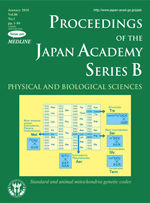巻号一覧

86 巻, 1 号
選択された号の論文の5件中1~5を表示しています
- |<
- <
- 1
- >
- >|
Reviews
-
Spectroscopy of antiprotonic helium atoms and its contribution to the fundamental physical constantsRyugo S. HAYANO2010 年 86 巻 1 号 p. 1-10
発行日: 2010年
公開日: 2010/01/14
ジャーナル フリーAntiprotonic helium atom, a metastable neutral system consisting of an antiproton, an electron and a helium nucleus, was serendipitously discovered, and has been studied at CERN’s antiproton decelerator facility. Its transition frequencies have recently been measured to nine digits of precision by laser spectroscopy. By comparing these experimental results with three-body QED calculations, the antiproton-to-electron massratio was determined as 1836.152674(5). This result contributed to the CODATA recommended values of the fundamental physical constants.
(Communicated by Toshimitsu YAMAZAKI, M.J.A.)抄録全体を表示PDF形式でダウンロード (1604K) -
– The non-universal genetic code, unusual features of the translational apparatus and their relevance to human mitochondrial diseases –Kimitsuna WATANABE2010 年 86 巻 1 号 p. 11-39
発行日: 2010年
公開日: 2010/01/14
ジャーナル フリーIn animal mitochondria, several codons are non-universal and their meanings differ depending on the species. In addition, the tRNA structures that decipher codons are sometimes unusually truncated. These features seem to be related to the shortening of mitochondrial (mt) genomes, which occurred during the evolution of mitochondria. These organelles probably originated from the endosymbiosis of an aerobic eubacterium into an ancestral eukaryote. It is plausible that these events brought about the various characteristic features of animal mt translation systems, such as genetic code variations, unusually truncated tRNA and rRNA structures, unilateral tRNA recognition mechanisms by aminoacyl-tRNA synthetases, elongation factors and ribosomes, and compensation for RNA deficits by enlarged proteins. In this article, we discuss molecular mechanisms for these phenomena. Finally, we describe human mt diseases that are caused by modification defects in mt tRNAs.
(Communicated by Takao SEKIYA, M.J.A.)抄録全体を表示PDF形式でダウンロード (3136K) -
Yoshiaki FUJII-KURIYAMA, Kaname KAWAJIRI2010 年 86 巻 1 号 p. 40-53
発行日: 2010年
公開日: 2010/01/14
ジャーナル フリーThe aryl hydrocarbon receptor (AhR) was originally identified as a ligand-activated transcription factor that is involved in the induction of xenobiotic-metabolizing Cytochrome P4501A1 (CYP1A1). For several decades, AhR has been studied in relation to toxicology and pharmacology. With recent discoveries on novel AhR functions, AhR research has expanded into multiple aspects of physiology, such as reproduction, innate immunity and tumor suppression. In this review, we summarize and discuss recent progress in mechanistic and functional studies on AhR with particular emphasis on physiological processes.
(Communicated by Takao SEKIYA, M.J.A.)抄録全体を表示PDF形式でダウンロード (999K) -
Kazutomo IMAHORI2010 年 86 巻 1 号 p. 54-61
発行日: 2010年
公開日: 2010/01/14
ジャーナル フリーAlzheimer’s disease has been characterized by senile plaque and neurofibrillary tangle in the brain. However, their relation to etiology of this disease has been left unclear. Recently it has been clarified that neurofibrillay tangle consists of highly phosphorylated tau protein. Then we have started to identify the enzyme(s) responsible for this phosphorylation and obtained tau protein kinase I and II. Tau protein kinase I phosphorylated not only tau protein but also pyruvate dehydrogenase, phosphorylation of which caused inactivation of this enzyme and finally led the cell to death. Then we have proved that TPKI is upregulated in AD brain but not in control brain. Upregulation of TPKI was induced by treating the neuronal cells with Aβ protein. Finally we have identified oligomeric aggregation of Aβ protein named Amylospheroid is highly potent to degenerate neuronal cells both in vitro and in vivo systems.
(Communicated by Kunihiko SUZUKI, M.J.A.)抄録全体を表示PDF形式でダウンロード (1156K) -
Naoki WATANABE2010 年 86 巻 1 号 p. 62-83
発行日: 2010年
公開日: 2010/01/14
ジャーナル フリーThe actin cytoskeleton drives cell locomotion and tissue remodeling. The invention of live-cell fluorescence single-molecule imaging opened a window for direct viewing of the actin remodeling processes in the cell. Since then, a number of unanticipated molecular functions have been revealed. One is the mechanism of F-actin network breakdown. In lamellipodia, one third of newly polymerized F-actin disassembles within 10 seconds. This fast F-actin turnover is facilitated by the filament severing/disrupting activity involving cofilin and AIP1. Astoundingly fast dissociation kinetics of the barbed end interactors including capping protein suggests that F-actin turnover might proceed through repetitive disruption/reassembly of the filament near the barbed end. The picture of actin polymerization is also being revealed. At the leading edge of the cell, Arp2/3 complex is highly activated in a narrow edge region. In contrast, mDia1 and its related Formin homology proteins display a long-distance directional molecular movement using their processive actin capping ability. Recently, these two independently-developed projects converged into a discovery of the spatiotemporal coupling between mDia1-mediated filament nucleation and actin disassembly. Presumably, the local concentration fluctuation of G-actin regulates the actin nucleation efficiency of specific actin nucleators including mDia1. Pharmacological perturbation and quantitative molecular behavior analysis synergize to reveal hidden molecular linkages in the actin turnover cycle and cell signaling.
(Communicated by Nobutaka HIROKAWA, M.J.A.)抄録全体を表示PDF形式でダウンロード (1554K)
- |<
- <
- 1
- >
- >|